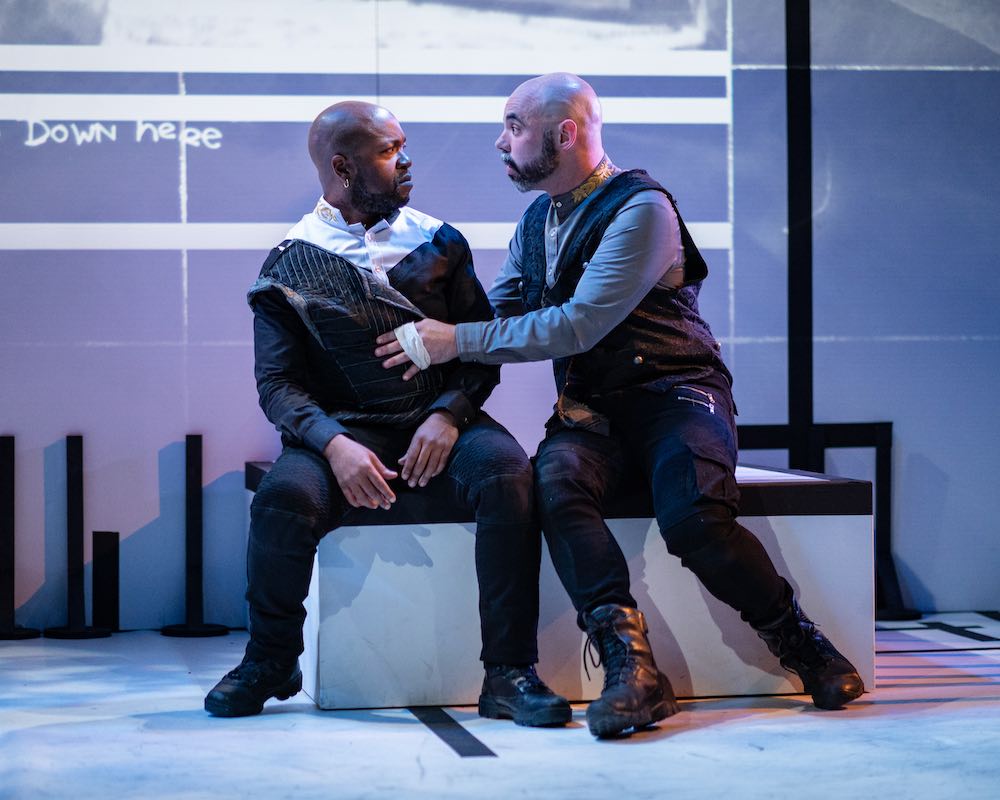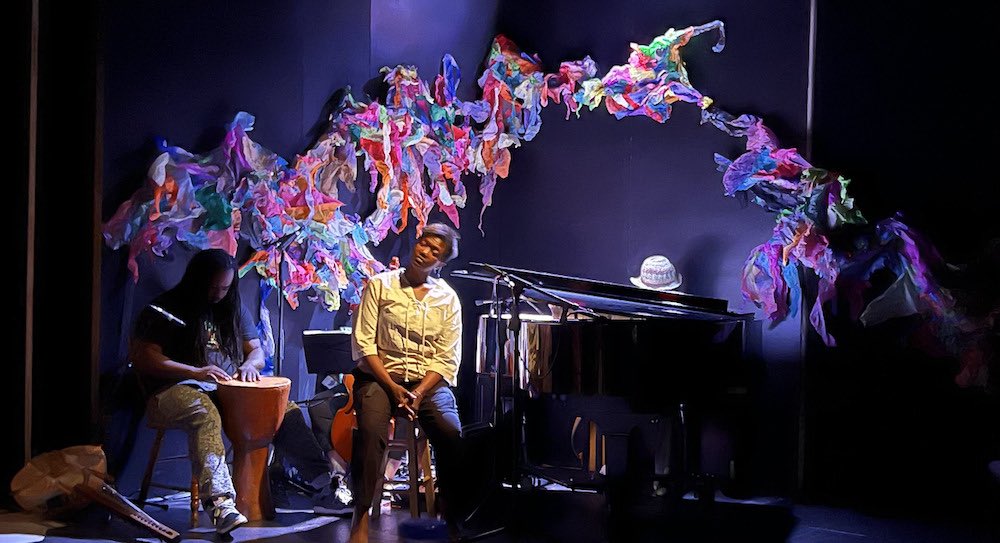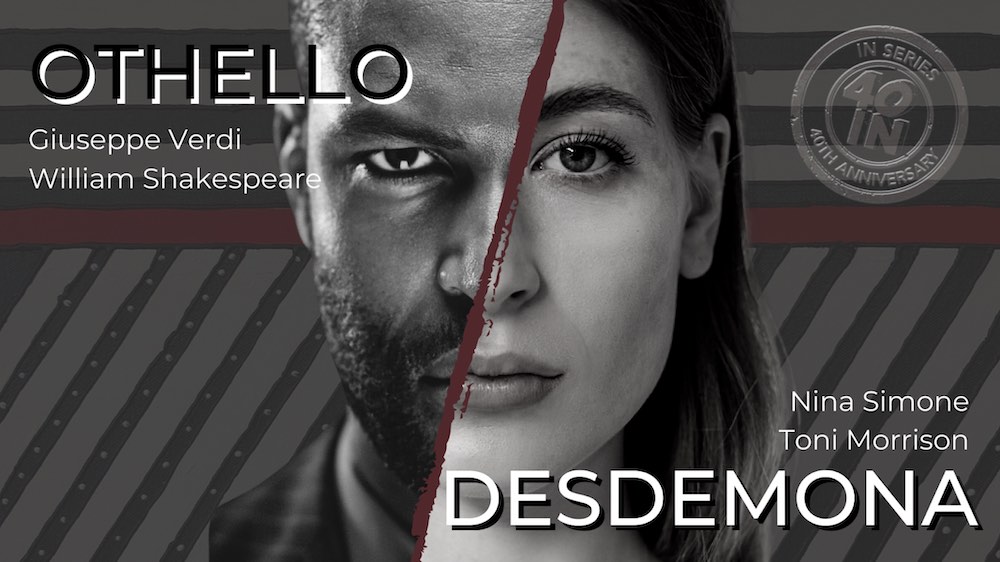My deal with Toni Morrison was: if I would do Shakespeare’s play, she would write a response to Shakespeare after 400 years… Othello tells the Venetian senate that he and Desdemona fell in love as he told her stories. Toni said, “I want to write those stories.” —Peter Sellars, American director
The term “unique” is often misused. But I would argue that in this case its use is justified. Othello/Desdemona is unique. It is a uniquely conceived, uniquely collaborative, and uniquely engaging production that you are not likely to be able to see anywhere else. If for no other reason than this you should not miss it. But there are many other reasons.
The IN Series current project — Othello/Desdemona — is really something. It is epic. It spans two evenings of performance. On the first night, you see a reenvisioned version of Verdi’s Othello, in which this opera has been realigned with Shakespeare’s words. On the second night, you see Toni Morrison’s Desdemona, the play that Peter Sellars challenged her to write after a lunchtime discussion about his dislike for the work.

The Othello portion of IN Series’ Othello/Desdemona refers to Verdi’s opera adaptation of the Shakespeare play of the same name. But the IN Series production did not begin with strains of music that would have been recognizable from Verdi’s work. Instead, it began with a sound from a woodwind instrument (Matthew Evan Taylor) that reminded me of a human groan or a moan. This sound came after we had been sitting — during the pre-show moments — looking at portions of Keith Piper’s “Go West Young Man,” which were projected through what looked a lot like the skeletal frame of a slave ship. One patron walked out after 10 minutes.
You can choose to see one production, or you can see both of them back-to-back. Each presentation is a worthwhile experience on its own. Seeing them both engages you in a conversation with yourself about race and art and how the ways we produce and engage in art and performance can serve either to support the status quo around race — white supremacy specifically — or can serve to open our hearts, minds, institutions, and processes to necessary and inevitable change.
The plots of the two plays are as follows:
Othello tells the story of a Venetian Moor — a Black man — who rises to the top of Venetian society through his masterful work as a commander of the military, leading Venice to victory over its enemies. He wins the top prize of this male-dominated society in the form of his marriage to Desdemona, who is from a Venetian (white) family. Othello’s ensign, Iago (a white man), is resolved to destroy Othello. The entire plot revolves around Iago’s manipulation of the very structures of the Venetian society that Othello has navigated and thrived within. Iago’s machinations create a trap in which Othello is convinced to destroy his own contentment: Othello will be convinced to kill the wife he loves and, after discovering how he has been deceived and manipulated into destroying everything he has worked for, he will kill himself.
Desdemona, Toni Morrison’s play, takes place in the afterlife: after the deaths of Othello and Desdemona. In it, Desdemona once again meets Barbary, the enslaved African woman who cared for her as a child. Barbary is only mentioned in the play: Barbary, betrayed in love, sang a song about a willow tree when she died. Desdemona sings the same song when she senses that she is about to die at the hands of Othello. In this play, both women get the opportunity that they did not have in the world of the canonical Othello to speak their truths.
My experiences of each play:
Othello takes place on a stage that is starkly black and white. The projections on the upstage wall (Jonathan Dahm-Robertson) of enslaved people in the holds of slave ships are black and white. The black and white writing on the walls cynically invites and entices the males of European descent, while taunting the enslaved, with the invitation to commodification “Go west, young man.” These projections are from Keith Piper’s 1987 series of photomontages of the same name. In this exhibit Piper “attempted to trace the history of the commodification of the Black male body, from its reduction to cargo in the hold of the slave ship, to migration, to the terror surrounding the Black male presence in contemporary society.”
The set evokes the hold of a slave ship, the ribs of the ship’s hull reflected on the upstage wall and imprinted on the floor. The opera takes place within these confines.

The production places Othello’s manipulation by Iago firmly within a pattern of European efforts to dominate Africans worldwide. While the point is not to be dismissed, for me, the projections of Piper’s work, while admittedly strong, did not strengthen and resonate with that theme as strongly or coherently as the actual staging of the performers did.
Iago’s presence in the background during moments when Othello was supposed to be alone is a case in point. It brought to mind prints I had seen of Black church gatherings in which a sole white male was present, withdrawn, silent and observant during the passionate and intimate worship services of Black folks. It suggested the internalized awareness of being watched.
In the moment when Othello wriths on the ground surrounded by other members of the cast, Othello is not in the same place as the others. But their words and intent constitute a kind of torturous nightmare.
While the staging served to refocus attention on what Othello was experiencing, the character of Iago was not in any way diminished. In fact, he seemed a bigger, more insidious force of cruelty, especially in the shape of Robert Mellon, whose rich, resonant deceptively comforting voice embraced the audience at the same time that Iago perpetrated his cruelty.
The black handkerchief! In both Othello and Desdemona, a black handkerchief was used. And it was a shock to see it. Every production of Othello I have seen until now has used a white handkerchief decorated with red strawberries — the white symbolizing Desdemona’s body and the strawberries being proof of her virginity preserved until Othello’s taking of it. It turns out that the universal presence of a white handkerchief with its red strawberries may, in fact, be the result of implicit bias in Shakespeare criticism and performance practice.
English professor Ian Smith’s research has pointed out that a closer, more receptive reading of what the text actually says would lead one at the least to acknowledge that the handkerchief was dyed. Othello himself says that the handkerchief was “dyed in mummy” — a black substance. So the handkerchief was probably not white. And that makes this cloth that Desdemona continuously kisses also more specifically identified with Othello’s body: an African presence cared for generation after generation by other Africans until it is entrusted to Desdemona.
Elizabeth Mondragon’s Emilia was a steadfast presence. Brian Arreola’s Cassio was an annoyingly oblivious opportunist. Walker Jermain Jackson’s Othello was an isolated and vulnerable man.
Maribeth Diggle’s Desdemona was not whiny or helpless. She was a Desdemona with her own agency.

Music Director Emily Baltzer was a fierce warrior of amazing stamina on the piano accompanying the voices, while Matthew Evan Taylor’s intimate compositions/improvisations and performances created a respite for the audience — a space that invited us into the production in a way that the assault of the opera itself, in the size of its sound and requisite physicality of its performance, often does not. That difference in how space is or is not made for the audience became even more marked while watching Desdemona. The press release for Othello/Desdemona put it this way:
Whereas, in the OTHELLO the theatrical world of Shakespeare and Verdi is closed, two-dimensional, and observational only, the experiential language of the second evening’s DESDEMONA is open, multi-dimensional, unlimited, and participatory. In her play Morrison is not only envisioning a new way to experience life from the perspective of the afterlife, but she is also teaching a new way of making theater that reflects the spirit of this understanding.
It is challenging. In the course of these two evenings, we are treated to vastly differing ways of encountering the same story and the same set of facts. (How one tells the story of the encounter of Europe with the rest of the world is very different depending on whether you are a beneficiary of white supremacy who has a vested interest in maintaining that system versus whether you are someone who has been a subject of its enforcement and who is devoted to dismantling it. That is one difference that is reflected in these two evenings.) Othello can be seen in two different ways. In one way of looking at and mounting the story, it is a cautionary tale and a justification for the continuation of white supremacy. If a white-based, male-dominated society allows Black people in, Black men will take your women and everything will end violently. Alternatively, Othello can be seen as a case study of how white-based societies systematically torture and destroy Black people who are too successful in them. In discussion with director Peter Sellars about the importance of performing Shakespeare’s Othello today, Toni Morrison noted: “Being in America today, it’s not that they kill what you love, it’s that they convince you to kill it.” This is the plot of Othello in a nutshell.
Watching the Verdi/Shakespeare, I was moved by how the staging illuminated Othello’s experiences, while my friend was not moved by much except the performance of Iago.
Watching Toni Morrison’s Desdemona, I was dazzled and delighted by the sets and music while my friend was visibly shaken and wept. A lot.
If Othello was insistently and inescapably black and white, Desdemona was walls, waves, currents, and gusts of color: inescapable color. The first thing you notice upon entering the theater is Maya Freelon’s ecstatically transcendent art installation, the colors of which surround and confront the audience. For me, it was a portrait of the ways in which both change and hope may be unavoidable. And most amazingly, we got to participate in this installation. We were given the option to choose a tissue paper of whatever color we wanted. At a certain point in the drama, we were invited/allowed to crumple this paper in concert with the performers on stage at a critical moment.
The music for this production is performed by master musicians. It is a once-in-a-lifetime gathering of this specific set of people. How they were able to bring together this group of folks, I will never know. I encourage you to see them if you can.

Music Director and Pianist Janelle Gill — the leader of a troupe of master musicians — has to have a lot of confidence. There was a feeling of play, joy, and daring in her performance. The cohesion that she encouraged in this ensemble was palpable.
Tina Chancey (strings) — director of Hesperus, one of DC’s premier artistic jewels — created along with Amadou Kouyate rich textures of sound that kept the audience buoyant in this exploration of the afterlife.
Amadou Kouyate (Djembe, Kora) — as the 150th generation of the Kouyate lineage — has studied and performed Manding music since he was three years old. And it shows! His is a joyful noise.
I first heard the crystalline voice of Claron McFadden (Barbary) in the IN Series production of A Faerie Queen. As soon as tickets were available for Othello/Desdemona we bought them. Witnessing the craft with which she engages with the music encourages a kind of meditative state. Especially when she hits those high pianissimos.
Maribeth Diggle plays Desdemona in both productions, which is a huge effort. Like many on this stage, Diggle is an international presence in opera and music. In Desdemona, especially, she contains and holds the audience’s anxieties and vulnerabilities while at the same time acting as a portal for their entry into the heart of the issues posed by Othello/Desdemona. It was impressive to watch her and it was comforting to accompany her through the work.
The music in Desdemona gently brought the audience into the play’s ritual of engagement between Desdemona and Barbary. The purpose of this engagement was the acknowledging, celebrating, and affirming of women and Black people in their resistance to those powers (such as the male- and white dominated world of Othello) that would deny their existence and silence their voices. In the original production of Desdemona, the voices of Black folks and women that had been silenced in the narrative of Othello were invoked through a collaboration between Toni Morrison and Rokia Traoré. The creators of the IN Series production arrived at the idea of tapping into Nina Simone’s legacy for that purpose. It was Simone who produced the definitive song “To Be Young, Gifted and Black,” which pointedly urged young Black people to embrace the idea, despite everything that was said about them to the contrary, that “your soul’s intact.” Also recruited into service was the music of Claudio Monteverdi, Barbara Strozzi, Omar Sosa and Yilian Canizares, and Tarquinio Merula. The show concluded with an apocalyptic invocation of determination and hope entitled “22nd Century,” a piece written by Exuma that had been sung by Simone.
Desdemona is more of a ritual like the oldest Greek dramas than it is like a plot-filled melodrama. It is filled with dancing and clapping guided by Motivators (some of the people I run with might even call them worship leaders — Sunny Feldman, Jazmyn Ja’Net, Erin Ridge, Judy Yannini).
In its ritual, the play offers us some words that help us name some of our obstacles to moving forward and, through naming them, reach for a space to exorcise them. Words such as these:
The language of love is trivial compared to the hidden language of men that lies underneath the secret language they speak in public.
My pride, my foolish pride in being human… is the source of so much evil.
And if we haven’t secured the passionate peace we yearn for, it is because we haven’t imagined it.
Othello: Can you forgive me?
Desdemona: No, I cannot. But I can love you and remain committed to you.
Othello: In spite of what I have described?
Desdemona: In addition to what you have described… I always knew you were caressing me with fingers hardened by swords and that your hands stroking my breasts also drew blood.
Othello plays June 9, 12, 17, and 19, 2022, presented by IN Series at Source Theater, 1835 14th Street NW, Washington, DC; and June 14 and 15, 2022, at Baltimore Theatre Project, 45 West Preston Street, Baltimore, MD. For tickets (starting at $65) go online.
The Othello program is online here. Running Time: Two hours with one 15-minute intermission.
Desdemona plays June 10, 11, 16, and 18, 2022, presented by IN Series at Source Theater, 1835 14th Street, NW, Washington, DC. For tickets (starting at $65) go online.
The Desdemona program is online here. Running Time: One hour 45 minutes with no intermission.
COVID Safety: IN Series requires that all guests, regardless of vaccination status, wear a mask while attending any IN Series performance. Additionally, IN Series requires patrons to show proof that they are fully vaccinated. The IN Series complete COVID Safety Plan is here.





